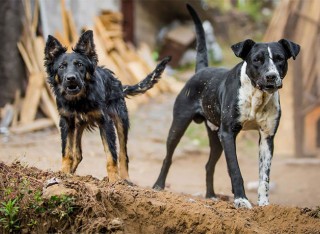
Dr Emma Taylor
About
Biography
Emma was the recipient of the Doctoral College Studentship Award 2018, allowing for her to undertake a PhD working at University of Surrey, School of Veterinary Medicine, and in collaboration with CDC Atlanta, USA, and Global Alliance for Rabies Control. Research generated from her PhD, saw Emma awarded Post Graduate Researcher of the Year 2022, for University of Surrey, before completing her PhD in 2023.
Emma now holds the position of Surrey Future Fellow, a prestigious three-year fellowship allowing her to develop her research. Emma is a member of the London Centre for Neglected Disease Research, and the Diseases of Neglected Communities Research group at Surrey, where her research focuses on:
- Using economic analysis to provide sustainable solutions for disease control.
- Conflict and the risk to disease control.
- Identifying the links between poverty and disease spread.
- Health care inequalities.
Emma is a recognised Fellow at the University of Surrey Institute for Sustainability, and at Royal Society of Arts.
My qualifications
News
In the media
ResearchResearch collaborations
Centre for Disease Control and Prevention, (CDC)
Global Alliance for Rabies Control (GARC)
London Centre for Neglected Tropical Diseases Research
Research collaborations
Centre for Disease Control and Prevention, (CDC)
Global Alliance for Rabies Control (GARC)
London Centre for Neglected Tropical Diseases Research
Sustainable development goals
My research interests are related to the following:




Publications
The global 2030 goal set by the World Organization for Animal Health (WOAH), the World Health Organization (WHO), and the Food and Agriculture Organization (FAO), to eliminate dog-mediated human rabies deaths, has undeniably been a catalyst for many countries to re-assess existing dog rabies control programmes. Additionally, the 2030 agenda for Sustainable Development includes a blueprint for global targets which will benefit both people and secure the health of the planet. Rabies is acknowledged as a disease of poverty, but the connections between economic development and rabies control and elimination are poorly quantified yet, critical evidence for planning and prioritisation. We have developed multiple generalised linear models, to model the relationship between health care access, poverty, and death rate as a result of rabies, with separate indicators that can be used at country-level; total Gross Domestic Product (GDP), and current health expenditure as a percentage of the total gross domestic product (% GDP) as an indicator of economic growth; and a metric of poverty assessing the extent and intensity of deprivation experienced at the individual level (Multidimensional Poverty Index, MPI). Notably there was no detectable relationship between GDP or current health expenditure (% GDP) and death rate from rabies. However, MPI showed statistically significant relationships with per capita rabies deaths and the probability of receiving lifesaving post exposure prophylaxis. We highlight that those most at risk of not being treated, and dying due to rabies, live in communities experiencing health care inequalities, readily measured through poverty indicators. These data demonstrate that economic growth alone, may not be enough to meet the 2030 goal. Indeed, other strategies such as targeting vulnerable populations and responsible pet ownership are also needed in addition to economic investment.
The Middle East, Eastern Europe, Central Asia and North Africa Rabies Control Network (MERACON), is built upon the achievements of the Middle East and Eastern Europe Rabies Expert Bureau (MEEREB).
MERACON aims to foster collaboration among Member States (MS) and develop shared regional objectives, building momentum towards dog-mediated rabies control and elimination. Here we assess the epidemiology of rabies and preparedness in twelve participating MS, using case and rabies capacity data for 2017, and compare our findings with previous published reports and a predictive burden model.
Across MS, the number of reported cases of dog rabies per 100,000 dog population and the number of reported human deaths per 100,000 population as a result of dog-mediated rabies appeared weakly associated. Compared to 2014 there has been a decrease in the number of reported human cases in five of the twelve MS, three MS reported an increase, two MS continued to report zero cases, and the remaining two MS were not listed in the 2014 study and therefore no comparison could be drawn. Vaccination coverage in dogs has increased since 2014 in half (4/8) of the MS where data are available. Most importantly, it is evident that there is a need for improved data collection, sharing and reporting at both the national and international levels.
With the formation of the MERACON network, MS will be able to align with international best practices, while also fostering international support with other MS and international organisations.
Background: Neglected tropical diseases (NTDs) disproportionately affect populations living in resource-limited settings. In the Amazon basin, substantial numbers of NTDs are zoonotic, transmitted by vertebrate (dogs, bats, snakes) and invertebrate species (sand flies and triatomine insects). However, no dedicated consortia exist to find commonalities in the risk factors for or mitigations against bite-associated NTDs such as rabies, snake envenoming, Chagas disease and leishmaniasis in the region. The rapid expansion of COVID-19 has further reduced resources for NTDs, exacerbated health inequality and reiterated the need to raise awareness of NTDs related to bites.
Methods: The nine countries that make up the Amazon basin have been considered (Bolivia, Brazil, Colombia, Ecuador, French Guiana, Guyana, Peru, Surinam and Venezuela) in the formation of a new network.
Results: The Amazonian Tropical Bites Research Initiative (ATBRI) has been created, with the aim of creating transdisciplinary solutions to the problem of animal bites leading to disease in Amazonian communities. The ATBRI seeks to unify the currently disjointed approach to the control of bite-related neglected zoonoses across Latin America.
Conclusions: The coordination of different sectors and inclusion of all stakeholders will advance this field and generate evidence for policy-making, promoting governance and linkage across a One Health arena.
In adult dogs, does feeding a raw food diet alter urine composition compared to a kibble diet?
Rabies was first reported in ancient Iraqi civilizations, yet it remains a poorly quantified and important public health threat in the region. Efforts to control rabies in Iraq including dog population control, and vaccination of livestock and dogs, have increased since 2010. Officially reported data on human rabies, dog bites, and animal rabies cases between 2012 and 2017 are analysed here to assess the effect of existing control efforts, to inform future strategies, and to highlight gaps in surveillance and reporting. The results of molecular characterization of 32 viruses from animal cases from throughout Iraq are presented, to improve the understanding of rabies dynamics in the animal reservoir. Although annual numbers of reported human cases were lower in the period between 2012 and 2017 than prior to 2010, human cases continue. There was a distinct gender and age bias among human cases with nine cases in males for every one female and twice as many cases in children than adults. Spatial clustering analysis and phylogenetic evidence suggests rabies is endemic throughout the country, with no regional variation in risk, but better surveillance and reporting is required to underpin control strategies.
The availability of next-generation sequencing techniques provides an unprecedented opportunity for the assignment of gene function. Streptococcus equi subspecies equi is the causative agent of strangles in horses, one of the most prevalent and important diseases of equids worldwide. However, the live attenuated vaccines that are utilized to control this disease cause adverse reactions in some animals. Here, we employ transposon-directed insertion-site sequencing (TraDIS) to identify genes that are required for the fitness of S. equi in whole equine blood or in the presence of H2O2 to model selective pressures exerted by the equine immune response during infection. We report the fitness values of 1503 and 1471 genes, representing 94.5 and 92.5 % of non-essential genes in S. equi , following incubation in whole blood and in the presence of H2O2, respectively. Of these genes, 36 and 15 were identified as being important to the fitness of S. equi in whole blood or H2O2, respectively, with 14 genes being important in both conditions. Allelic replacement mutants were generated to validate the fitness results. Our data identify genes that are important for S. equi to resist aspects of the immune response in vitro, which can be exploited for the development of safer live attenuated vaccines to prevent strangles.


